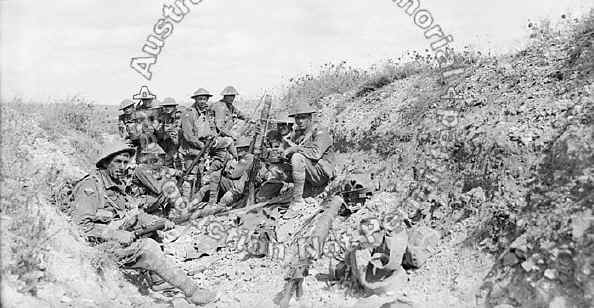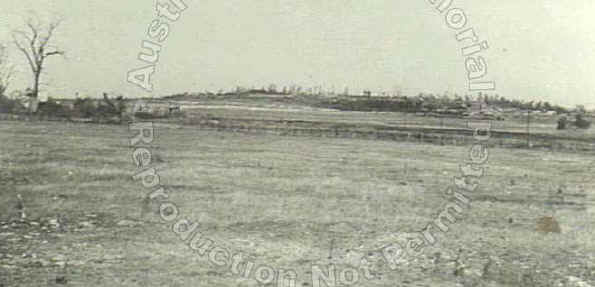|
In March 1918, the
German people were close to starvation and growing tired of the war.
With the collapse of the Russian Front, and the imminent arrival of
American troops to assist the Allies on the Western Front, German
Commander, Erich von Ludendorff, decided to attack the weakest part of
the British lines near the Somme River. On 21 March 1918,
"Operation Michael" was launched and by 5 April 1918, the
Germans had gained 60 kilometres of territory before their progress
was halted.
On 9 April 1918,
another offensive "Operation Georgette" was launched against
the British lines near Armentieres with the intention to push the
British troops to the English Channel. By 29 April strong
resistance by the British had blocked the German advance. On 27
May 1918, the Germans launched a third offensive near Reims and by
July had reached the Marne River, 70 kilometres from Paris.
Although the German
army had made great advances, after three months of fighting their
soldiers were fatigued and were weakened by an outbreak of influenza
in June. The great advances had strained supply lines and the
morale of the troops was lowered. By mid July the German army
was in retreat.
On 8 August the Battle
for Amiens (also known as the Third Battle of the Somme) commenced
when a combined Australian, British and Canadian forced attacked the
Germans eastwards from Villers-Bretonneux. The offensive broke
the German line so thoroughly that most of their field artillery was
overrun and captured. The Allied troops advanced 10 kilometres
on the first day of fighting which prompted Erich von Ludendorff to
label it 'the black day of the German army'. By 11 August over 30,000
German prisoners had been captured. At the conclusion of the
Battle for Amiens on 28 August 1918, the Australian
casualty toll exceeded 6,500.
By the end of August
1918, the last German stronghold was located at Mont
St Quentin, which overlooked the
Somme River approximately 1.5 kilometres north of Peronne. Its
location made it an ideal observation point and strategically, the
hill's defences guarded the north and western approaches to the town.
Although Mont St Quentin, only 100 metres high, was a key to the
German defence of the Somme line, Field Marshall Haig felt that
there was no immediate need to push the Germans from this location.
Major
General John Monash, the
Australian Corps Commander, was keen to capture the stronghold with
Australian troops. Monash believed that by taking control of
Mont St Quentin, the line of the Somme River would be useless to the
Germans as a defensive position and they would be forced to retreat to
the Hindenburg Line. To achieve this, it was necessary to capture Mont
St Quentin. Monash proposed that the 2nd, 3rd and 5th Australian
Divisions were to take part in the attack despite their numbers being
heavily depleted during earlier fighting.
 |
| Lieutenant A. V. Sedgwick MC and
some of his party from the 24th Battalion, awaiting the lifting
of the artillery barrage on Mont St Quentin, photographed a few
minutes before moving out of the trench to engage in the renewed
attack on the Crater at 1.30 p.m. on that date. This attack, by
men from the 21st, 23rd and 24th Battalions, successfully
captured Mont St Quentin. |
The 5th Division was to
take the Peronne bridges, and a wooded spur east of Peronne, the 2nd
Division was to aim for the bridgehead at Halle and then move on to
Mont St Quentin and the 3rd Division was to take high ground northeast
of Clery and the Bouchavesnes spur. Audaciously, Monash planned
that Mont St Quentin would be taken by three battalions in the direct
part of the assault.
On 29-30 August the 5th
Brigade (comprising the 17th, 18th, 19th and 20th Battalions) of the
2nd Division, seized hills that dominated the river crossings
and proposed approach route. Their numbers had been depleted
during earlier fighting and the troops were exhausted. Each
battalion's strength was down to around 300 men.
The 17th Battalion (on
the right flank) was to seize the village of Mont St Quentin and the
small wood on the summit beyond the road; the 20th Battalion (on the
left flank) was ordered to seize the line of the road down the
northern slope to the Feuillaucourt Bridge and the 19th
Battalion was to guard the right flank by occupying two parallel
trenches which ran down the south western slope of Mont St Quentin and
overlooked Peronne. The 18th Battalion was assigned the job of
close support to the assault battalions.
On the night of 31
August 1918, the Australian troops crossed the Somme and following an
artillery barrage which commenced at 5 am, attacked Mont St Quentin
from the north west. During the infantry charge, Australian
soldiers had to fight uphill across open ground where they were
vulnerable to attack from the German held heights above. The
17th Battalion headed up the Brasso Redoubt, and climbed towards
Gottleib Trench. They encountered the enemy almost
immediately and charged the enemy posts, yelling at the top of their
voices.
The demoralised
Germans, fearing they were being attacked by a superior force,
surrendered in large numbers. The 20th Battalion moved up to
make a bayonet charge and captured the Gottleib trench. As the
Australians reached the summit, large numbers of German soldiers were
sent fleeing down the slopes. By 7 am the troops had occupied
the village of Mont St Quentin and the slope and summit of the hill.
However, the small size of their forces meant that their hold on the
position was tenuous. The reserve element of the 2nd German Guards
Division, an elite German unit, counterattacked and drove the troops
from the summit to positions just below the summit.
In the rear, the 19th
Battalion crossed the Somme at the Clery bridge, which Australian
engineers had saved and repaired despite enemy barrages. On the same
morning the 33rd Battalion (9th Brigade) of the 3rd Division attacked
the Bouchavesnes spur, a position which allowed the Germans to
dominate Mont St Quentin, and were held up by enfilade fire from a
machine gun. Private George Cartwright, stood up and moved
forward, stopping every few steps to shoot.
He killed three of the
machine gun team and then rushed ahead and threw a grenade at the
post. As it exploded, he charged, captured the gun and eight
prisoners. He was awarded the Victoria Cross for his actions.
Although the 33rd Battalion only held part of their objective, a
concerted effort was made, the spur was secured and the left flank of
the troops attacking Mont St Quentin was secured.
|

|
| A general view of Mont St Quentin
from the south. A corner of Quinconce Cemetery is seen on the
left. The country beyond the railway, running across the centre
of the picture, was that advanced over during the renewed attack
of 21st, 23rd and 24th Battalions, at 1.30 pm on 1 September
1918. |
On 1 September, the 6th
Brigade (21st, 22nd, 23rd and 24 Battalions) seized the summit
on their second attempt. The 14th Brigade of the 5th Division (53rd,
54th, 55th and 56th Battalions) captured the woods north of Peronne
and after pressing on during a short-lived German attack, took
the main part of Peronne. An attempt to pass the northern
side of the town was stopped by heavy fire from the ramparts. On 2
September the 7th Brigade (25th, 26th, 27th and 28th battalions) drove
beyond the mount, the 15th Brigade (57th, 58th, 59th and 60th
Battalions) seized the remainder of Peronne and the 3rd Division
advanced on the northern flank. By the evening of the 3
September, the Australian held Peronne, captured Flamicourt the next
day and then advanced two miles to the east.
The 3rd Army and the
Canadians thrust towards Cambrai during the same period, and this gave
General Ludendorff additional cause to retire from the Somme below
Peronne. His only option was to retreat to the Hindenburg Line, which
had been breached by the British near Bullecourt. The British
had built three lines facing the Hindenburg line which had been
captured by the Germans in the March offensive. By 11 September,
the Australians had won the first of these lines by peaceful
penetration, but the second and third lines were too strong and on 18
September an attack launched by the British 4th Army who despite heavy
rain and fog, achieved success.
In the second stage of
the advance, the Australian 1st Division on the left achieved the
second and third objectives. On the right the Australian
4th Division infantry, worked its way up open valleys to the dense
wired protecting the Hindenburg "Outpost" Line. By
dawn on September 19, a great part of the Australian line looked down
on the St Quentin Canal and the Hindenburg Line beyond. The two
Australian divisions captured
4,300 prisoners and 76 guns in
this offensive and it was reported that captured German soldiers had
said that their men would not
now face the Australians.
This latter battle highlighted the low morale of the German forces and
paved the way for the attack on the Hindenburg line itself.
The Battle of Mont St
Quentin resulted in a strategic, tactical and psychological victory
for the Australian Forces and dealt a stunning blow to five German
divisions, including the elite 2nd German Guard Division, drove the
enemy from one of the key positions in France, and took 2,600
prisoners at a cost of slightly over 3,000 casualties. It was
fought without tanks and creeping barrages and demonstrated that rapid
and flexible manoeuvring could play a decisive part in capturing enemy
positions on the Western Front. Australians attacked more than
their number of Germans in strong positions and captured more of them
than they could safely hold.
Twenty percent of the attacking force were listed as casualties
proving it had not been a walkover.
Text from Penrith
City Council site
|